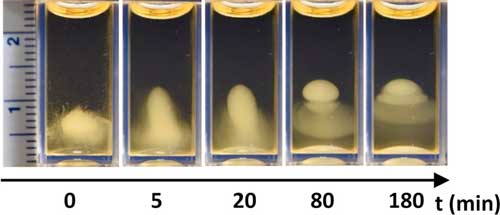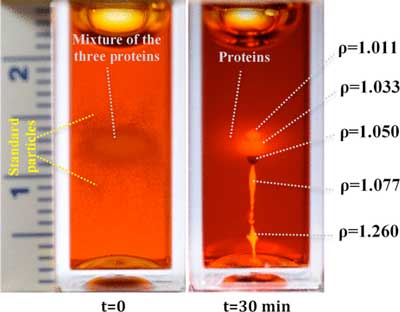| Jan 13, 2020 | |
Magnetically levitating proteins to precisely measure their density |
|
| (Nanowerk Spotlight) The density of proteins in solution is an important fundamental biophysical quantity that has not been accurately measured yet. This has led to extensive debate in the literature regarding the precise density value of proteins. So far, researchers have been commonly using an estimated average density value of ∼1.35 g/cm3 for proteins independent of their nature or molecular weights. | |
| "This rough density metric can often lead to inaccurate estimates on the other physicochemical and composite protein features, especially after their interactions with other materials such as nanoparticles," Morteza Mahmoudi, an Assistant Professor in the Precision Health Program at Michigan State University, tells Nanowerk. "In our present work, we demonstrate a new technique using superparamagnetic iron oxide nanoparticles (SPIONs) for magnetic levitation (MagLev), which promises a more precisely measurement of the density of proteins in solution." | |
| These findings are published in Analytical Chemistry ("Magnetically Levitated Plasma Proteins"). | |
 |
|
| Formation of ellipsoidal patterns from levitated plasma proteins over time, in MagLev platform and 0.06 mg/mL concentration of SPIONs. (Reprinted with permission by American Chemical Society) | |
| This study of the density of protein molecules in solution reveals that the density of plasma proteins in solution is not exclusively a function of molecular weight. In addition, the scientists found that density of plasma proteins in solution has a constant value of 1.03 ± 0.02 g/cm3, which is significantly lower than the ∼1.35 g/cm3 commonly assumed in the literature (which was originally deduced from hydrodynamic and adiabatic compressibility experiments). | |
| Furthermore, for the first time, the team used a superparamagnetic iron oxide nanoparticle (SPIONs) solution instead of the conventional paramagnetic solutions (e.g., GdCl3, MnBr2, MnCl2, etc.). | |
| These results suggest that the MagLev technique may provide useful insights into the measurement of densities for better understanding the physicochemical properties of proteins (e.g. protein-protein interactions) in solution and their interactions with solvating water molecules. | |
| "Using SPION solutions instead of paramagnetic solutions may enable MagLev to levitate a wide range of biomolecules in solution in a reasonable period of time (i.e., a few hours)," Mahmoudi points out. "It therefore may pave a way for the development of additional biomedical applications including point of care diagnosis and quality assurance testing of macromolecules." | |
| The researchers are currently working on early detection of various kind of diseases such as MS and cancer using MagLev. Quality control of various kinds of materials/products is another area that could benefit from the use of MagLev techniques. | |
| "One of our next research steps will be the study of the exact mechanism behind the formation of multiple ellipsoidal plasma patterns in the MagLev platform," says Mahmoudi. "We plan to study configurational or structural variations of individual plasma proteins and any possible protein-protein interactions, which may cause a change in solution density of plasma proteins." | |
 |
|
| Levitation profiles of three mixed different molecular weights of single proteins (lysozyme, albumin, and immunoglobulin G (IgG)) mixed with five standard density (all density units are g/cm3) fluorescent polyethylene microspheres in the MagLev system (1 mg/mL concentration of SPIONs). It is noteworthy that the color change is due to the employed higher concentration of SPIONs compared to the other figures. (Reprinted with permission by American Chemical Society) | |
| Since MagLev is a method that works based on the differences of the density of materials, it could be an ideal technique for the separation of materials from mixtures. | |
| In addition, MagLev is a robust and highly reproducible technique to solve a broad range of problems in physics, chemistry, engineering, and biology, including analysis of food and water, quality control of materials, diagnosis, kinetics of chemical reactions, and self-assembly. | |
| One of the goals of the research team is to miniaturize the MagLev system towards a point-of-care device for disease detection. They caution, though, that there are two major challenges that need to be overcome: | |
| One is that the time required for levitation closely depends on the size of the diamagnetic materials; a limitation that causes prohibitively long times of separation due to Brownian motion. This time and size limitation could prevent the practical use of MagLev for many applications in which short-time separations of sub-micrometer objects are essential. | |
| The other problem of the use of MagLev in biological/biomedical applications is the toxicity or bio-incompatibility of the current paramagnetic solutions (e.g., GdCl3, MnBr2, MnCl2). Biocompatible SPIONs could help overcome that. | |
 By
Michael
Berger
– Michael is author of three books by the Royal Society of Chemistry:
Nano-Society: Pushing the Boundaries of Technology,
Nanotechnology: The Future is Tiny, and
Nanoengineering: The Skills and Tools Making Technology Invisible
Copyright ©
Nanowerk LLC
By
Michael
Berger
– Michael is author of three books by the Royal Society of Chemistry:
Nano-Society: Pushing the Boundaries of Technology,
Nanotechnology: The Future is Tiny, and
Nanoengineering: The Skills and Tools Making Technology Invisible
Copyright ©
Nanowerk LLC
|
|
|
Become a Spotlight guest author! Join our large and growing group of guest contributors. Have you just published a scientific paper or have other exciting developments to share with the nanotechnology community? Here is how to publish on nanowerk.com. |
|
